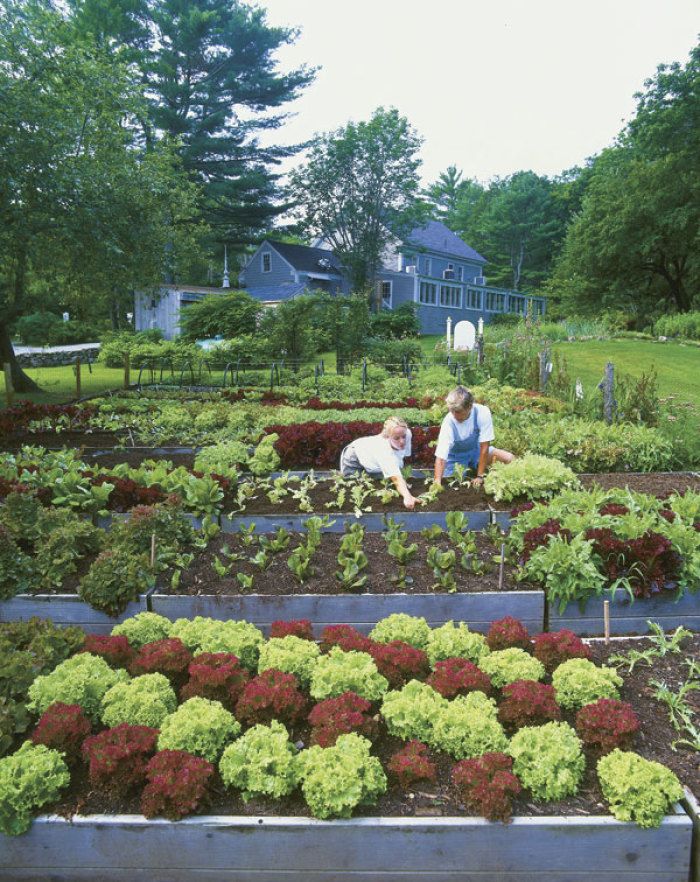
by Warren Schultz
April 1999
from issue #20
At Arrows Restaurant, the garden is always there. As you arrive, you see it in the window boxes overflowing with crisp, lime-green lettuce plants mixed with nasturtiums. You see it in the outrageous floral displays in the dining room. It’s on the menu, and on your plate, from appetizer to entrée. And as you enjoy the taste of the fresh, homegrown produce, you can gaze out the window at the cool greens and deep burgundy reds, row after row, in the 3⁄4-acre kitchen garden behind the restaurant.
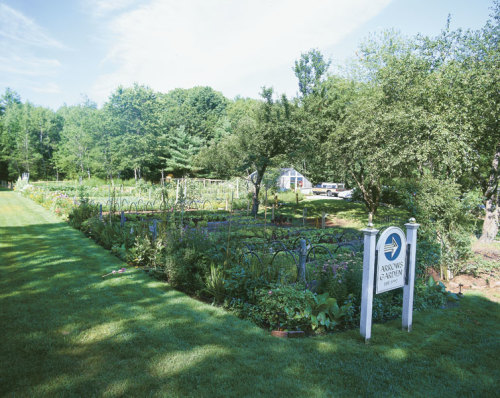
At the front entrance to arrows, edibles are combined with ornamentals in a stunning planting. Under the kitchen windows, culinary and medicinal herbs share space with lettuces and ornamentals in the geometric beds, and windowboxes brim with more lettuce and nasturtiums. |
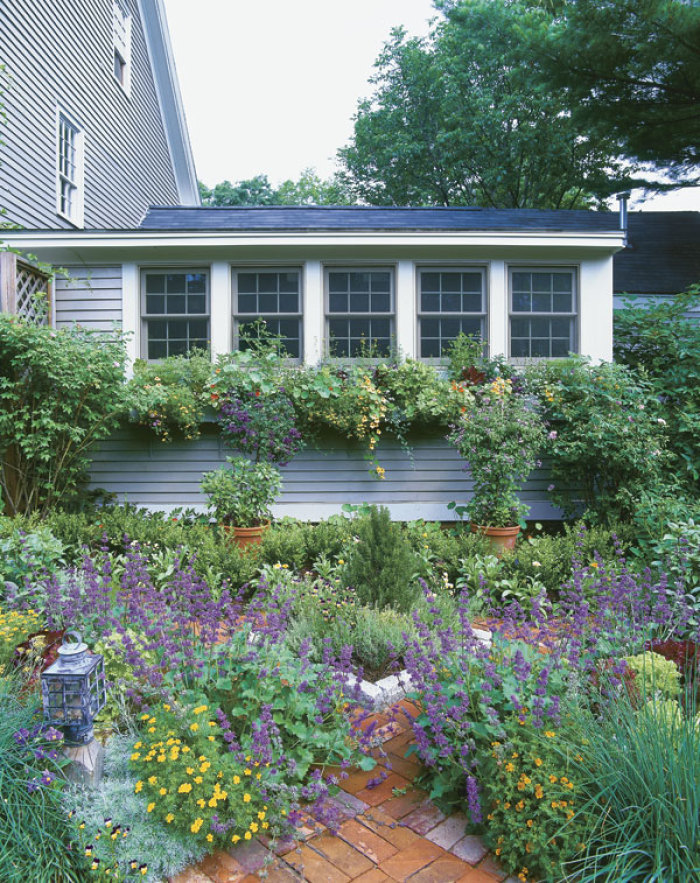 |
|
Like many successful gardens, this one was born of necessity. In the spring of 1988, Mark Gaier and Clark Frasier, chefs and co-owners, opened Arrows restaurant in an 18th century farmhouse just up the road from the tourist town of Ogunquit, Maine. Their classic country restaurant soon began earning rave reviews for its cuisine. The partners believed in incorporating fresh local vegetables in their preparations. But that wasn’t always easy in Maine in the late 1980s. “We weren’t very pleased with the quality of the produce we could get,” Clark explains. “And the specialty items—anything exotic or different—just weren’t available.”
They had the land, they had the need, so they decided to grow their own. Despite their limited knowledge of horticulture, the garden was a success, right from the start. “We began it in 1992,” Clark says. “The next year, we realized the garden was too small for our volume of business, so we doubled the size. The year after that we increased it by another third, and then another two-thirds.”
In just as few years, the garden became an integral piece of the Arrows dining experience. It is now as much a part of the restaurant as is the kitchen or the dining room with its wide plank floors and exposed beams. “A lot of guests arrive early so they can walk through the garden before dinner,” says Clark. As they stroll from the restaurant through an arch and into the garden, they’re immediately surrounded by waves of greens. From there they walk past beds thick with herbs or overflowing with edible flowers. There are tall trellises of tomatoes with bright annuals climbing enthusiastically over them. There are beds of eggplant with leathery leaves so green they’re almost purple. And lettuces, in more shapes, textures, and shades of green and red than the owners ever imagined.
Maximizing the harvest
It’s all as neat and orderly as a display garden. But in reality this is a working mini-farm, providing most of the vegetables to a kitchen that feeds 600 people a week, from April through November. This may be the ultimate test of a kitchen garden. There’s no margin for error, no room for ragged crops. It must balance productivity, taste, innovation, and beauty.
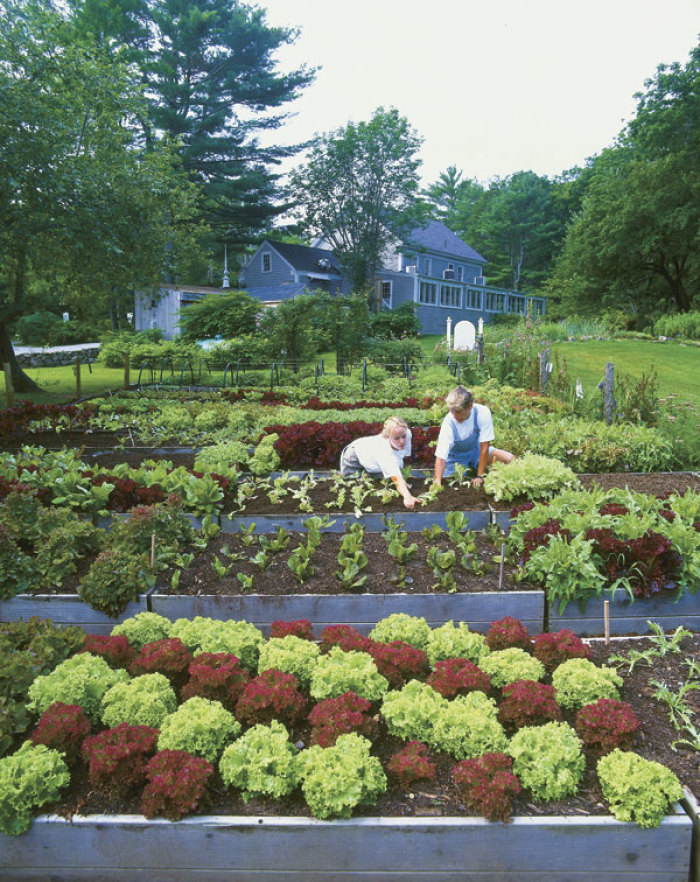 |
When a box has been harvested and the soil replenished, the space is immediately replanted with seedlings. Every box gets four shovels of compost and a sprinkling of organic fertilizer before a new crop is set out.
Starting seeds in cell packs allows precise spacing of plants, eliminating the need for thinning, and also permits having fun with planting patterns (see the bed in the foreground of the photo). |
|||
The underlying structure of the garden is rectangles and right angles. But the planting scheme and the shapes and colors and textures seem to break through those boundaries. The garden is laid out in parallel, wood-sided beds, 24 feet long, and 3 or 4 feet wide. Each is subdivided into 6-foot-long sections, which head gardener Marcia MacDonald calls boxes. “I love the boxes,” she says, “because they look lovely—clean and crisp—and they allow us a lot of control over the crops.” They form the backbone of her reliable production system. Don’t let the garden’s beauty fool you. This place is all business.
Marcia has designed a system that keeps the garden productive, simplifies scheduling, and helps keep the garden fresh and beautiful day after day. She works hard to eliminate as many variables as possible, and treats every gardening day as though it’s the first day of the season.
At the Arrows garden, Marcia can’t allow summer doldrums or autumn neglect to take root. So she does no direct sowing in the garden—ever. Every seed is started indoors, under lights, where temperature, light, water, and humidity can be controlled. She starts the seeds in a sterilized soil mix in cell packs, 72 cells, each about 1⁄2 inch square. “The nice thing is that you get one plant per cell, and they can go right from there into the garden,” she says. “No thinning is required.”
From March until September, Marcia has something to sow almost every evening at home. She starts a crop of a popular variety every two weeks. After sowing the seeds, Marcia puts the flats under lights immediately. “Most people don’t understand that seedlings require an incredible amount of light—up to 16 hours a day,” she says. “Putting them in a sunny windowsill just won’t do it.”
When the seedlings sprout, she feeds them Sea Cure liquid seaweed and Roots Plus, an organically based fertilizer. After about two weeks under lights, the coddling is over. It’s out to the greenhouse for a short stay before they go into the ground. “The minute they hit the greenhouse they go crazy,” she says. Of course, not every gardener is blessed with a greenhouse, but Marcia says a cold frame makes a good substitute. Failing that, a shady, protected spot under a tree in the summer will do.
After two weeks in the greenhouse, the seedlings are ready for the garden, provided the garden is ready for them. As soon as a box has been harvested, she transplants the seedlings directly into the rich, crumbly soil. By transplanting rather than direct sowing, she says, “We get perfect placement and good air circulation. It’s easier for us, and it looks beautiful.” Four weeks later, the lettuce is ready to harvest, and by then there’s a fresh crop waiting in the greenhouse.
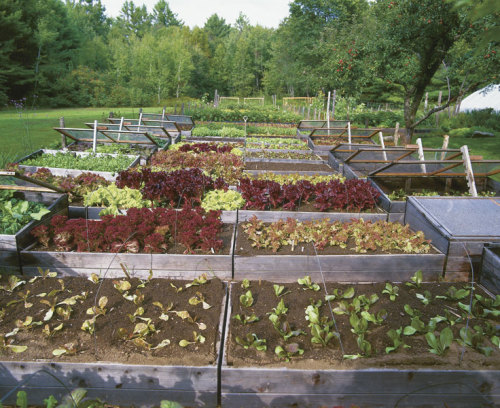 |
| Feeding 600 people a week from a garden that is also on public view requires skillful planning and management, as well as a green thumb. The lettuce boxes have removable lids that turn them into cold frames, allowing harvest until Thanksgiving. |
Production can be beautiful
This strict regime, along with good soil, not only keeps the garden productive, but helps keep it beautiful as well. Crops never linger past their prime in the garden. “When you’re gardening organically, it’s very important to get things out so nothing rots,” Marcia says. And healthy plants are good looking plants. It doesn’t matter how much thought you’ve given to design, how you’ve arranged your beds, or how cleverly you’ve incorporated different colors and textures—if the plants are ragged the garden won’t look good.
Working with established plants, rather than seeds, makes it easy to create designs in the beds with different colors and leaf forms. “The fun part of using cell packs is they make it easy to create designs of stripes or circles or any shape,” Marcia says. “I call it lettuce art, and the bed is my canvas. For example, I always make a trademark arrow with a spiky ‘Royal Oak’ lettuce, and surround it with lettuce of a different color. In some of the beds, I make stripes or waves of ‘Red Merlot’. And we try to grow showy greens in the front of the garden to make a pleasing visual presentation for the guests.”
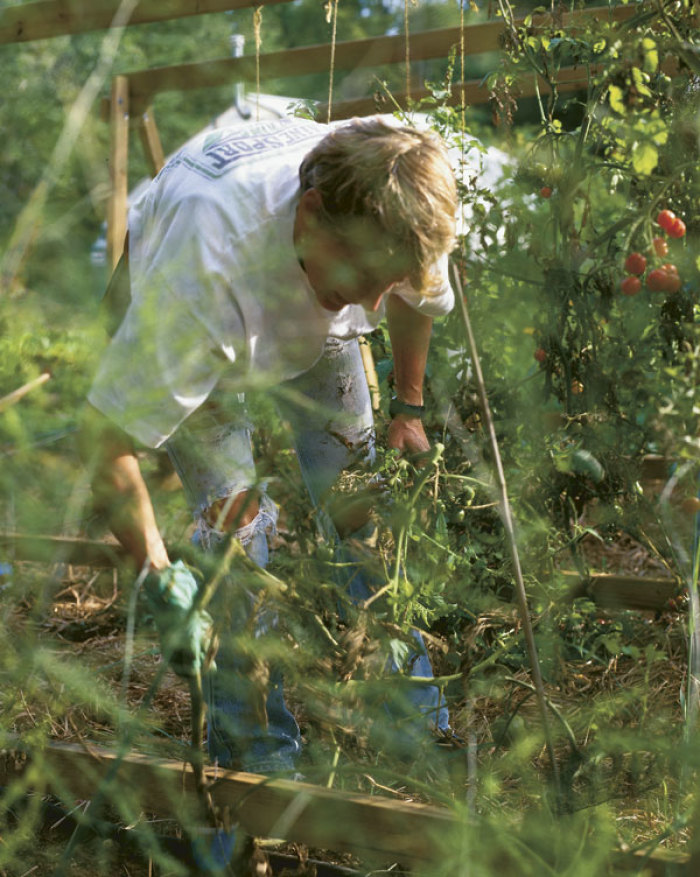 |
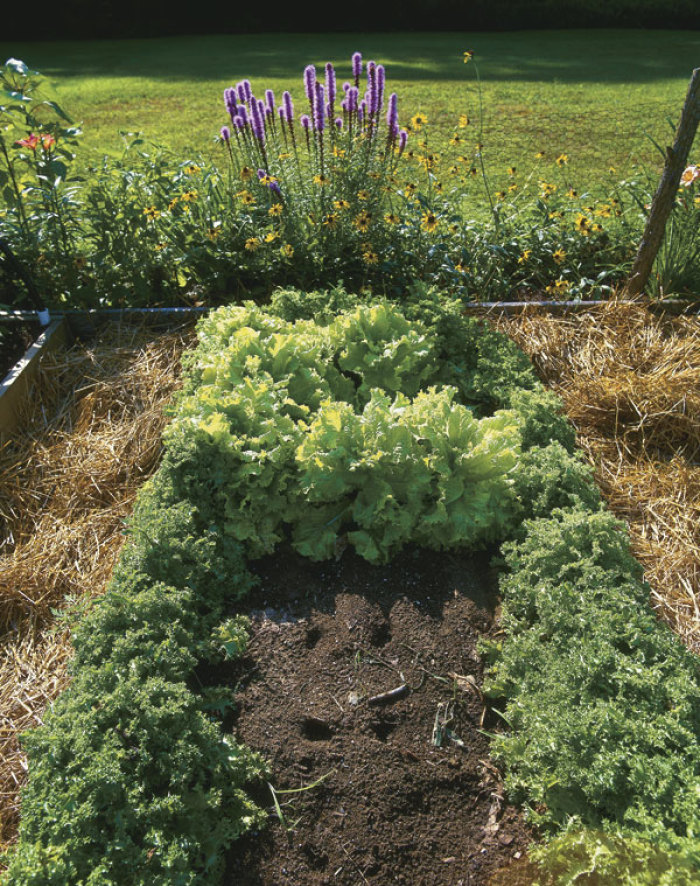 |
|
| Good garden hygiene means plants must come out as soon as they stop producing; this also makes room for systematized succession planting. | The garden gets a truckload of loam, 30 yards of compost, and 30 bales of peat yearly. North Country Pro fertilizer, dolomitic lime, and greensand are also added. | |
Of course, there’s a lot more to the garden than greens. The garden is a mélange of tomatoes, eggplant, peppers, leeks, squash, edible flowers, herbs, and much more. All are handled with the same creative hand. Marcia uses flowers as borders, rosemary and bachelor buttons along the aisles, marigolds edging a row of blueberries. She sees tomatoes—sometimes scraggly plants that other gardeners hide —as an opportunity to beautify the garden. “We’ll grow a ‘Yellow Pear’ or maybe a ‘Chadwick’ cherry tomato up the tepee, then plant borage with its beautiful, edible blue flower, around it. Maybe we’ll put some ‘Red Splash’ calendula around the bottom, with an ‘Alaska Mix’ nasturtium or a ‘Tangerine Gem’ marigold.”
Though the garden is only a few steps away from the kitchen, keeping the two in sync requires a lot of cooperation between the gardener and the chefs. Clark visits the garden at least twice a day. Every Sunday, he and Mark walk through the garden with Marcia, as they begin planning the week’s menu. “I tell them what they can expect for the week,” says Marcia. “What’s limited, what we have a lot of.”
Clark takes it from there. “After I coordinate with Marcia as to what’s available, Mark and I write the menus around the garden. We have a daily menu so if we have a small crop of something we can use it for a couple of days and then use something else.
During the off-season, Mark and Clark and Marcia sit down to make a list of varieties for the next year’s garden. “The bottom line is it has to work well on the menu,” says Mark. “It always comes back to the kitchen.” And Marcia never loses sight of the why of the garden. “It’s really for the clientele,” she says. “They’re getting the freshest, most beautiful, and wonderful-tasting vegetables they could ever get anywhere.” Clark agrees. “There’s a discernible difference in the taste of our food,” he says. “There’s nothing like harvesting that morning and having it on the menu that evening.”
| Choice vegetable varieties from the Arrows kitchen garden |
|
The Arrows kitchen garden is a real-world trial garden, where crops are chosen for productivity, appearance, and taste. Head gardener Marcia MacDonald grows hundreds of varieties there, adding new ones every year and eliminating ones that don’t measure up. Last year she grew “Of all the lettuces, my favorite is ‘Samantha’,” she says. “It’s a gorgeous chartreuse green with ruffled leaves, and it has an enormous amount of taste. ‘Cocarde’ is another beautiful lettuce, a variegated spiky deer tongue type. And we always grow ‘Red Salad Bowl’ and ‘Green Salad Bowl’.” Other regulars in the garden are: ‘Sylvetta’, ‘Astro’, and ‘Rucola’ arugula; ‘Osaka Purple’, ‘Green Wave’, and ‘Red Giant’ mustard greens; and ’Medusa’, ‘Inferno’, and ‘Rossana’ radicchio. “I love eggplant,” Marcia says, “Because the plant and the fruits are so beautiful.” She grows 12 varieties, including ‘Turkish Orange’, ‘Violette di Firenze’, and ‘Tango White’. As for tomatoes, she always plants a good, modern variety, such as ‘Big Beef’, for productivity, and heirlooms for flavor and looks. “We grow an enormous number of heirloom tomatoes,” she says, “‘Brandywine’, ‘Persimmon’, ‘Green Zebra’, ‘Big Rainbow’—the visual appearance on the plate is very important to us.” Many of the varieties mentioned here are offered by Seed Savers Exchange. |
Photos: André Baranowski

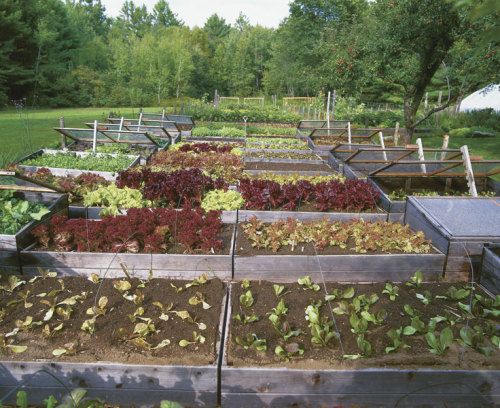



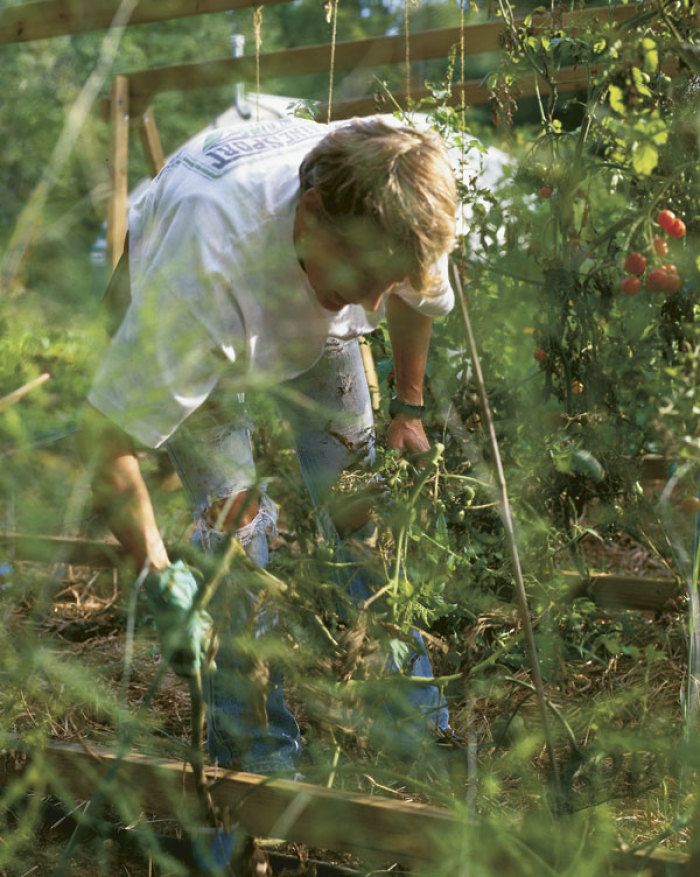

















Comments
Log in or create an account to post a comment.
Sign up Log in